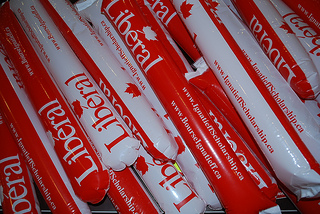“For ’tis the sport to have the enginer hoist with his owne petar, an’t shall go hard. But I will delve one yard below their mines, and blow them to the moon.” — Hamlet, Act 3
“Hoist with your own petard.” Meaning: “Injured by the device that you intended to use to injure others.” — The Phrase Finder
For many years, Liberals have been eager advocates of “strategic voting” — the idea that it makes sense to vote for a party you don’t support in order to avoid the election of a party you don’t support even more.
A pitch to this effect has been part of the closing argument of every federal Liberal campaign since at least 1993.
Arguably, it was all that Michael Ignatieff had to say (that anyone heard) during the 2011 election. In as many words, his pitch was that only the Liberals can stop the Tories; you don’t want the Tories; so you must vote Liberal. There was a red door and a blue door, and those were your only choices.
In my view, in the long term, the political drug that is “strategic voting” has had almost as much to do with the destruction of the federal Liberal brand as the Paul Martin’s 1995 budget and the sponsorship scandal. It reduced one of Canada’s great historical legacy parties to a tactic: Tick this box to avoid that box. The federal Liberals had more than that to say about their history, their tradition, their values, and their odd elite interests-brokerage approach to public affairs. But they didn’t, which leaves them where they are now. In a poor mathematical position to make federal strategic voting pitches in the future. And with much work to do to reassemble a case for themselves based on anything else.
But there is, possibly, something even more interesting to say about strategic voting. And that is this: Liberal voters seem to be uniquely vulnerable to it.
In 2011, Stephen Harper won his majority in large part by making a direct strategic voting appeal to formerly Liberal voters in suburban Toronto (what another politician likes to think of as “Ford nation”). You only have to look at the map to see how that worked out — an awful lot of suburban Toronto red doors became blue doors.
In 2012, Alison Redford made another direct strategic voting appeal to formerly Liberal voters, centred in Calgary and Edmonton. The Alberta Liberals got 26.4 per cent of the vote in the last election — and only 9.9 per cent last week. There is no doubt this is what saved Premier Redford (the NDP vote under Alberta NDP Leader Brian Mason, on the other hand, improved nicely: 8.5 per cent last time, 9.8 per cent this time).
Meanwhile, the car-crash-that-never-ends that is the premiership of British Columbia’s Christy Clark is now apparently thrashing around to the view that it needs to scrub the Liberal brand off itself, to fight off both a principled and a strategic voting pitch aimed at its voters from both the left (the B.C. NDP) and the right (the B.C. Conservatives).
Conservatives and New Democrats at both the federal and provincial levels have an interesting opportunity to pay the Liberals back in more of their own coin in future elections. The challenge is to do so without being consumed by this tactic. To delve one yard below it, as Shakespeare put it so elegantly, without a fatal over-investment in it.
This article was first published in the Globe and Mail.



